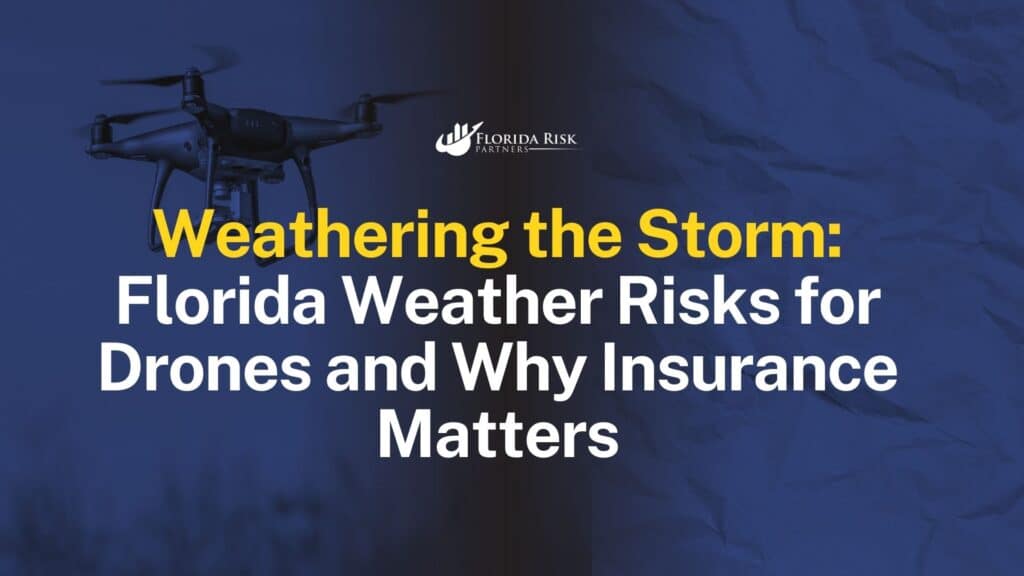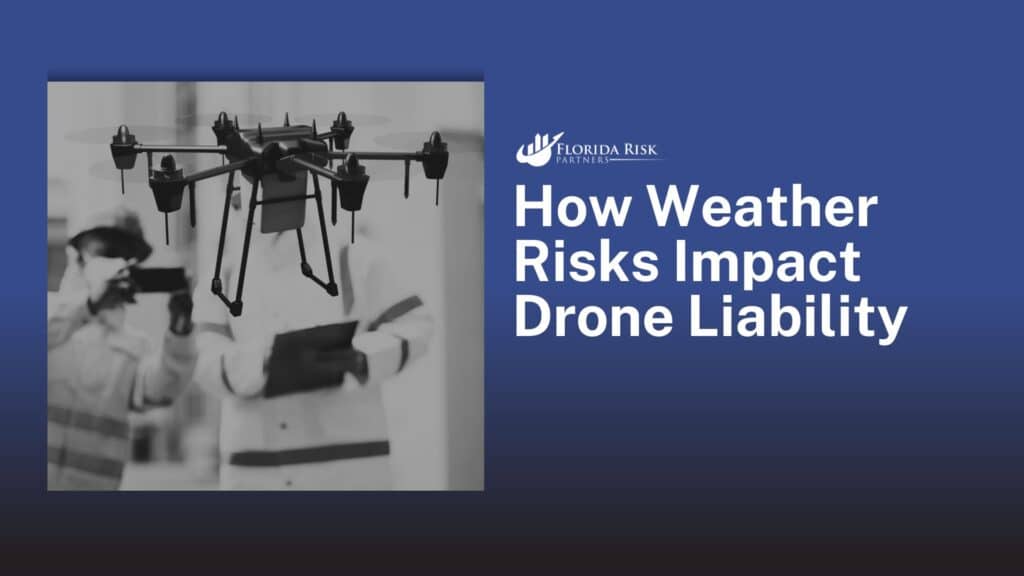-
Main Office: 1434 E. Bloomingdale Ave Valrico, FL 33596-6110
-
Phone: (888) 601-6660
-
Email: info@floridariskpartners.com

Florida is known for its sunshine and palm-lined coastlines, but anyone who has lived here for more than a minute knows the truth—Florida weather is as unpredictable as it is beautiful. And if you’re flying drones in the Sunshine State, that unpredictability poses some serious risks. From pop-up thunderstorms to the full-force fury of hurricane season, weather plays a massive role in the safety and success of any drone operation.
Whether you’re a seasoned commercial pilot flying multi-thousand-dollar drones or a recreational hobbyist capturing beach footage on the weekends, understanding Florida drone weather risks and preparing for them is critical. That preparation doesn’t end with monitoring weather apps or performing pre-flight checks. It includes properly insuring your drone and your operations against the unpredictable. In this post, we’ll explore the specific weather-related risks drones face in Florida, how those risks affect your liability and equipment, and how drone insurance in Florida is a must-have shield when the weather decides not to cooperate.
Why Florida’s Climate Is a Unique Challenge for Drone Pilots
Florida might be called the Sunshine State, but that’s only part of the story. The state also ranks as one of the most weather-volatile areas in the country, especially during the late spring through fall months. Sudden thunderstorms, high humidity, heavy winds, lightning, and hurricanes all come into play—and they can wreak havoc on even the most advanced drones.
Let’s start with the storms. In many parts of Florida, especially inland areas like Orlando or Central Florida’s agricultural zones, it’s common to start the day with blue skies only to be facing a severe thunderstorm by early afternoon. These storms often come with gusty winds, torrential downpours, and frequent lightning strikes, creating a dangerous environment for unmanned aerial vehicles.
Then there’s the annual hurricane season, which officially runs from June 1 through November 30. During these months, Floridians live under the constant threat of named storms forming in the Atlantic or Gulf of Mexico. For drone operators, this is a period that demands extra caution—and extra protection. Even if you’re not flying during the height of a hurricane, the surrounding wind fields, storm bands, and atmospheric instability can make the airspace treacherous.
Finally, there’s the issue of humidity and salt air, especially along Florida’s vast coastline. These elements can corrode sensitive electronics, degrade batteries, and interfere with sensors—problems that don’t cause crashes immediately, but can increase the odds of mechanical failure over time.
When you add up all of these conditions, Florida quickly becomes one of the most challenging states in the country to operate a drone reliably. That makes weather-related drone damage a leading cause of equipment loss and mission failure—and a top reason to carry comprehensive drone insurance in Florida.
How Weather Risks Impact Drone Liability
It’s not just about what weather can do to your drone—it’s about what your drone can do to others when the weather goes sideways.

Imagine you’re operating a drone for a roofing inspection in Tampa. The weather looks fine at takeoff, but 10 minutes into the flight, a sudden gust catches your drone and sends it spiraling into a neighbor’s window. Or maybe you’re shooting a beachfront property in Fort Myers, and a strong breeze off the Gulf causes your drone to lose stability and fall onto a moving vehicle in the street. These are real risks, and they happen all the time—especially in Florida.
In cases like these, even though the weather was technically to blame, you as the operator are still legally responsible. The FAA and Florida courts won’t give you a pass just because it was windy. In fact, you’re expected to assess conditions prior to flight and exercise good judgment. If you fly in poor conditions and your drone injures someone or damages property, you can be held personally liable for the consequences.
This is where drone liability insurance becomes critical. A robust commercial drone insurance Florida policy or recreational policy with liability protection can help cover the cost of:
- Property repairs
- Medical expenses for injured parties
- Legal defense fees
- Judgments or settlements
But—and this is important—insurance doesn’t cover reckless or unlawful behavior. If you knowingly fly in restricted weather conditions, or ignore advisories and warnings, your insurer may deny the claim. That’s why good risk management is a partnership between safe piloting and strong insurance coverage.
The Toll of Weather on Drone Equipment
Let’s talk about the hardware. Even if your drone doesn’t cause injury or property damage, weather can still destroy your equipment—and that’s a hit to your wallet if you’re not covered.
Florida’s environment throws a lot at your drone:
- Rain can fry electrical systems and gimbals
- Humidity can corrode contacts and internal components
- Wind gusts can lead to crashes or water landings
- Salt air along the coasts can rust and pit metal parts
- Heat can degrade batteries and cause GPS or motor malfunctions
These risks aren’t reserved for hurricanes either. A routine flight in Jacksonville, Pensacola, or Miami during a hot, humid afternoon can slowly erode your drone’s reliability. Over time, these environmental conditions increase the likelihood of system failures mid-flight.
That’s why hull coverage—insurance for physical damage to your drone and equipment—is just as important as liability coverage. It ensures that if your drone is lost or damaged due to Florida’s extreme weather, you can recover financially. Whether your drone crashes into a canal during a wind gust or short circuits from unexpected rainfall, hull and payload insurance picks up the slack where warranties and DIY repairs can’t.
Hurricane Response and Commercial Drone Operations in Florida
Interestingly, Florida is also a hotbed for post-hurricane drone activity. After major storms, commercial drone operators are frequently called in to assess property damage for insurers, inspect infrastructure, or survey flooded areas. This work is critical—but it’s also risky.
Operating in post-hurricane environments means:
- Navigating unstable buildings
- Dealing with ongoing wind and rain
- Working near power lines or debris
- Flying in areas with heavy air traffic from emergency responders
Even with experience and careful planning, the risk of drone loss or causing unintentional damage is high. That’s why commercial drone insurance in Florida is often required for companies or contractors hired to perform these assessments. Liability coverage helps protect against third-party claims if something goes wrong, while hull coverage helps the operator recover from equipment damage or loss.
Many commercial clients—including insurance companies, municipalities, and real estate developers—will not even hire a drone operator unless they can provide a certificate of insurance with specific weather-related endorsements. If you’re planning to work during or after hurricane season, make sure your policy explicitly allows for storm-related operations, and that your coverage limits reflect the high-risk nature of the work.
Risk Mitigation: What Pilots Should Do Before Flying in Florida Weather

Insurance is the financial safety net—but smart flying is your first line of defense. To reduce the likelihood of weather-related incidents, Florida drone pilots should make pre-flight weather assessments a non-negotiable part of their routine.
Here’s what every operator should be doing:
Monitor Weather with Trusted Tools
Use apps and aviation weather services like UAV Forecast, Windy, or the FAA’s B4UFLY app to check for:
- Wind speeds
- Gusts
- Rain probability
- Cloud ceiling
- Visibility
- Lightning proximity
Don’t just look at conditions at launch. Check for what the forecast looks like 30 minutes into your mission and what’s happening downrange of your planned flight path.
Know Your Drone’s Limitations
Every drone has manufacturer-specified wind resistance limits and operating temperatures. Know what yours can handle—and don’t push it. Operating outside of those specs could not only cause a crash but also void warranties or trigger insurance exclusions.
Avoid Coastal and Inland Afternoon Flights During Summer
During Florida’s hot months, thunderstorms often build throughout the day and explode in the afternoon. Schedule your flights for early morning whenever possible to avoid this peak instability period.
Perform Thorough Post-Flight Checks
Weather damage isn’t always immediate. After each flight, especially one conducted in humid or salty environments, check your drone for:
- Corrosion
- Dirt or salt buildup
- Moisture intrusion
- Sensor or camera glitches
Regular maintenance can extend your drone’s life and prevent mid-air failures.
Insurance Policy Tips for Weather Coverage in Florida
Not all Florida drone insurance policies are created equal—especially when it comes to weather coverage. Here are a few things to look for when selecting or reviewing your policy:
- Explicit coverage for weather-related equipment loss or damage
- Named perils vs. all-risk coverage (all-risk is more comprehensive)
- Coverage for in-transit and post-event use (especially during hurricane recovery)
- Add-ons for payloads and ground equipment
- Reasonable deductibles and replacement cost valuation
Also, be sure your insurer doesn’t include exclusions for “Acts of God” that could nullify a claim after a severe storm. Clarify what their process is for filing claims after weather-related damage—especially in storm-impacted regions where communication may be down.
Final Thoughts: Prepare for the Skies, Expect the Unexpected
Flying drones in Florida offers incredible opportunity. From commercial roof inspections and agricultural surveys to epic beach footage and post-storm assessments, there’s no shortage of airspace to explore and value to provide. But that opportunity comes with a weather warning—literally.
In a state with some of the most volatile weather in the U.S., drone operators must prepare for the unpredictable. And that preparation starts with respecting the forecast and continues with carrying the right insurance. Whether you’re a commercial pilot flying high-end gear or a recreational user flying a prosumer drone on weekends, drone insurance in Florida protects not just your hardware, but your reputation, business, and financial well-being.
Next week, we’ll explore how drones are transforming Florida’s booming construction industry—and what that means for managing risk on job sites. Until then, fly safe, fly smart, and always check the weather twice.
Call Us Or
Schedule an Appointment
Select an agent below to view our online calendars and select a day and time that works best for you or call us directly at 888-601-6660. When you use our online calendars, you will receive an email with more information.



